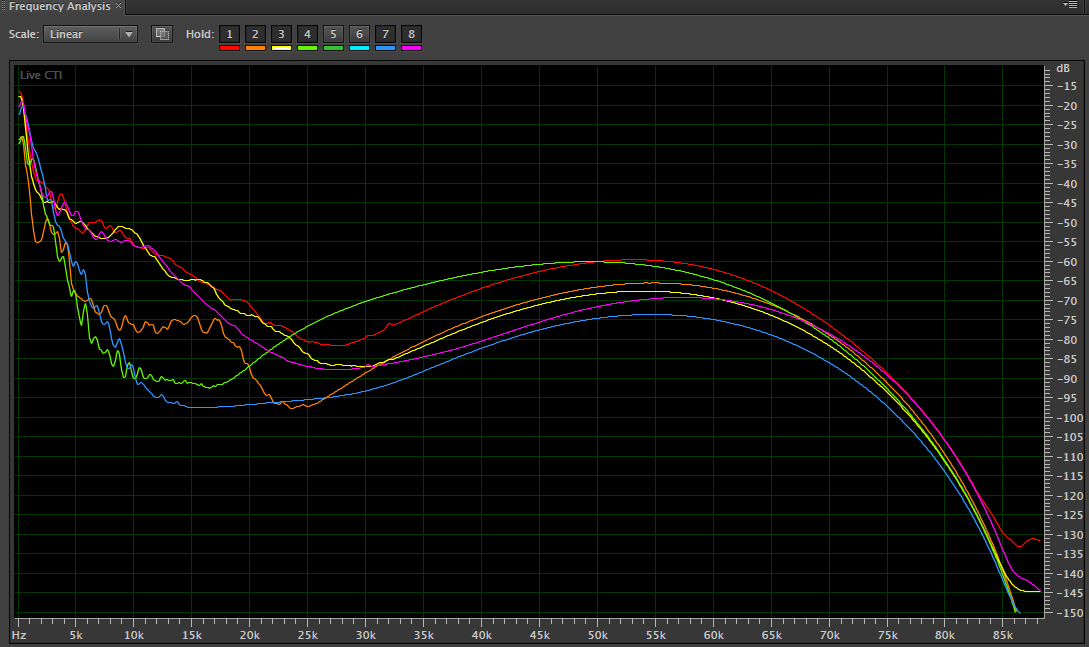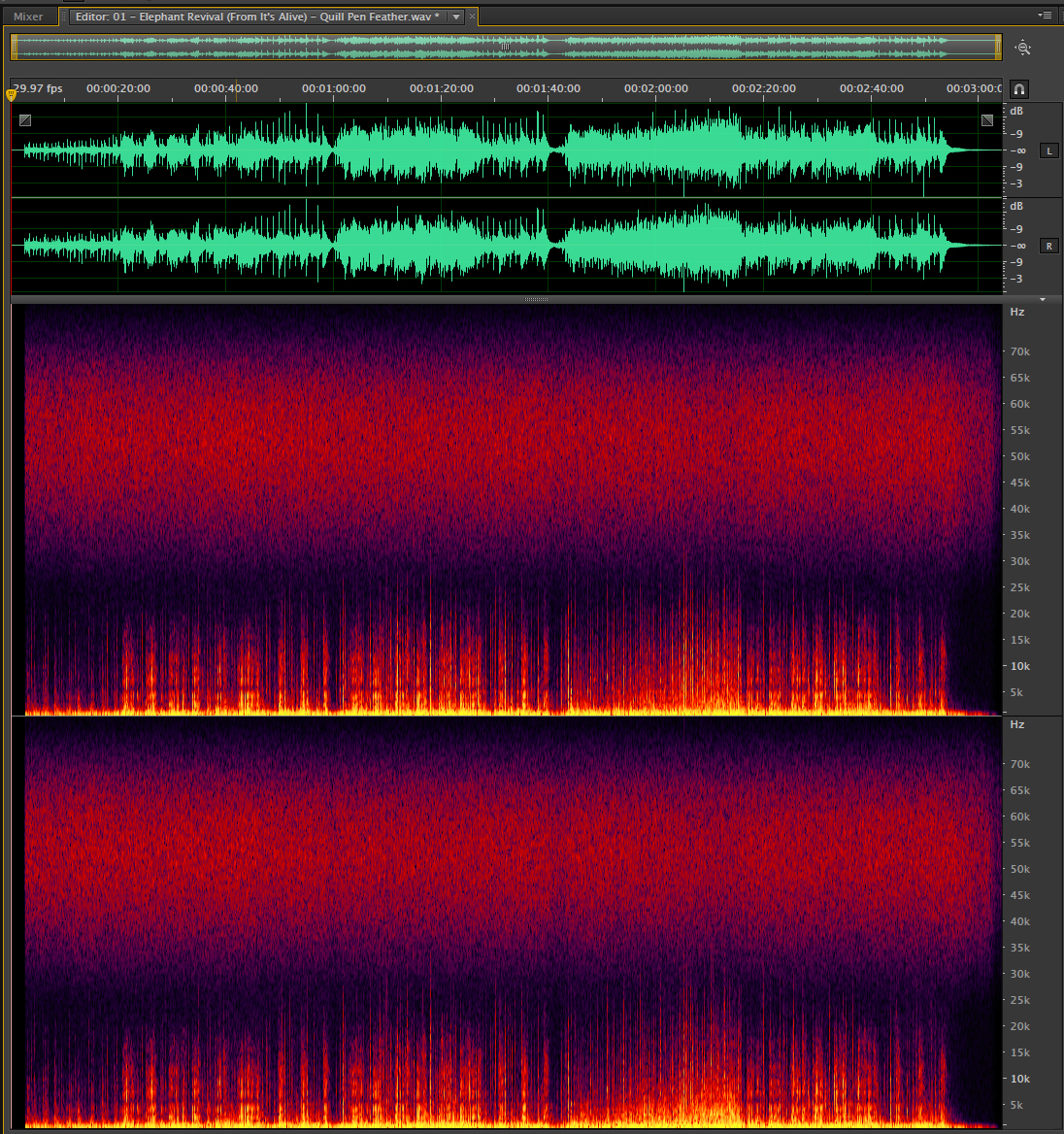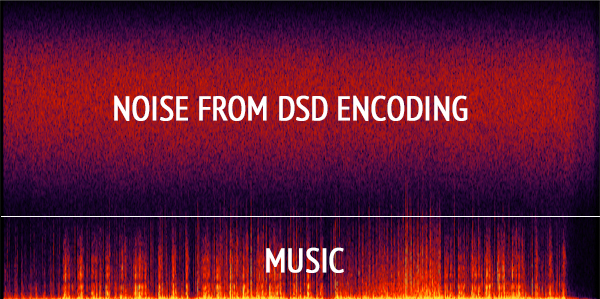One: A Rainbow of Colors
The blurb at the top of the PS Audio page claims the fidelity of the collection of tunes on their audiophile compilation SACD disc is “nothing short of stunning”. My own description would be somewhat less generous. All of the tunes are very nice studio recordings, produced and recorded by capable engineers, and performed by talented musicians. But in spite of the 176.4 kHz 24-bit PCM specifications, the fidelity of all of the tracks is about equivalent to a standard CD and no better. As I’ve stated many times, well-done compact discs can sound terrific…and the files that I downloaded do sound very good. That’s the subjective assessment. How about the technical side of the picture?
Let’s start with a spectral plot. I opened each and every one of the tracks, selected the entire track, and performed a spectral analysis. The figure below shows a veritable rainbow of colors. Each color reflects the spectrum of one tune. I didn’t include all of the tracks on this plot…but they all show the same telltale pattern of DSD…there is a huge ultrasonic rise caused by the noise produced by a 1-bit encoding system. In order to improve the dynamic range beyond 6 dB (the amount 1-bit is capable of delivering), a process called “noise shaping” pushes the “in band” (20-20kHz) noise out in to the ultrasonic range where your ears won’t hear it. That’s great for your ears but your equipment will try to reproduce it! And that can be very problematic.

Figure 1 – The spectra of 6 of the tunes from ONE [Click to enlarge]
The files have a sampling rate of 176.4 kHz, which means that audio frequencies up to 88.2 can be captured and delivered. But look at what’s present just past the “audio band” in the analysis above…nothing but noise. Is it really beneficial or desirable to download a couple of hundred megabytes of data per tune when the majority of the ones and zeros contain nothing but noise?
There are a few tunes among the 10 that have musical content higher than 20 kHz but not by much.
Take a look at the spectra of the first tune on the album. This is the waveform and spectra in a different type of display.

Figure 2 – The spectra of “Quill Pen Feather” by Elephant Revival [Click to enlarge]
The big cloud in the middle of the plot is all noise that has been shifted out from the audio band. This is the fundamental problem with DSD…especially at 2.8224 MHz or DSD 64, which is the sample rate of the Sony Sonoma system used to produce most of these recordings.
The production of the tunes on the “One” compilation disc is excellent, the tunes are nice enough, and the musicians are wonderful. But the project doesn’t reap the benefits of high-resolution audio with regards to frequency or dynamic range. I’m tempted to downconvert the 176 kHz/24-bit PCM files to CD specs and let you take a listen. I doubt very seriously if you would be able to tell them apart. But I don’t want to distribute the intellectual property owned by others.
Tomorrow, I’ll take a look at the dynamic range of the collection.


Hi Mark, a CD down conversion raises an interesting question. Wouldn’t the 44.1/16 down conversion remove all that ultrasonic noise, meaning equipment won’t try to reproduce it, meaning it could actually sound/perform better??
Absolutely it would…and the file would be one quarter the size of the ridiculous 176.4 kHz version. It certainly wouldn’t sound worse.
Get out your helmet and flac jacket Mark, I get the feeling of incoming on the horizon. LOL
Iam still not convinced About hi Rez audio and all the hype That a lot of people spending over inflated prices On music we mostly have like say a older album how can they take a album done say 40 years ago from analog and make it sound better as most say they can hear a different . By adding noise to the file . More zeros and ones…….trun up the dramatic range and everything sounds cleaner and better cause it is diff.i did a blind test on my system with a so called hi Rez file and a cd File using a oppo 103 and I couldn’t tell a diff only the hi Rez played louder not necessary better. To much snake oil out there until things get sorted Out I will wait too jump into Hi Rez
I not convinced either because virtually all of the hype and marketing and content pitched as “High-resolution” music isn’t high-resolution! It came from a CD or an analog tape, which aren’t high-resolution formats. If you really want to process a file with the latest tools and remaster the original, you an change the sound but it’s still not HR.
Hi Mark, keep up the great work revealing sad charlatans like Paul McGowan. I read his columns with a mixture of hilarity and then almost disbelief for the saturation with self adulatory remarks that subliminally are constant marketing blurb for PS Audio. “nothing short of stunning” is standard stuff, just like “Music Room 1”, always suggesting that no-one but no-one else has the definitive equipment or the refined criteria like Paul. But then you discover that he is a science fiction novelist, and I guess that gives the whole game away. In fact he is also an audiophile novelist, ha ha ha, 100% deluded into believing his own stories. Whenever I hear in Pianoman the words “real estate novelist”, I immediately think of PM and laugh out loud.
Of course, to be fair, PS audio does make SOME nice equipment, but it is all just so over-priced and the serious components are mixed up with snake-oil items like power regenerators, cables and accessories, all “nothing short of stunning” to Paul´s golden (with $$$) ears. OMG, an ongoing audiophile reality show. However the truly sad issue is that the $$$ are captured from poor consumers, wowed by the brilliant pulp-fiction …
I don’t believe Paul is a charlatan. He has a very successful company and believes in what he says…but he also knows that he has to market his products. Everyone in business knows that. I do it too. He and I don’t agree on a bunch of things but I do consider him a friend and colleague.
He collaborated on the “One” project to help the musicians, the owners of a couple of studios, and to issue an “audiophile” quality demo in DSD.
I didn’t know that he was a novelist…but why not? PS Audio makes some very nice equipment. My first high-quality DAC was made by PS Audio many years ago.
Mark,
I admit I didn’t expect anything else.
I also have to admit that I stand on the PCM side of the fence 😉
Thanx for your work.
I knew what I would find when I analyzed the files on the “One” disc. Knowing Gus and his process, the DSD pollution simply had to be there. I find it incredible that anyone would advocate for a format that have 75% noise in it.
…very interesting. apart from the size of the ‘high-res’ file due to useless information, how will this affect the the performance of the system you play these files with? I mean, all this ‘useless-information’ (app75%), even if inaudible by itself, has to be processed. how much energy of the power-amplifier will go ito it? so, does it have an undesireable audible effect indirectly by subtracting power needed to ‘perform’ the audible bandwidth (just to discribe it in unscientific terms ;-))? we all know the negative effect of ultra low inaudible frequencies on the performance of tracks due to the high power consumption of bass frequencies, so how is it with ultra high frequencies, especially if they’re covering 75% of the present range?
That’s the problem…your hardware doesn’t have the limitations that your ears do, so it tries to deal with the excessive amount of noise. It’s not filtered out, which would make a lot more sense. But then you couldn’t sell a 176.4 kHz file! There are lots of negative effects caused by having tons of ultrasonic noise present in your audio files.
Someone should attend one of these sessions and let us know what they’re trying to demonstrate here at the T.H.E. Show next week:
http://www.theabsolutesound.com/articles/wireworld-brings-the-best-test-of-cable-fidelity-to-the-show-newport-2016/
Joe, I have a session booked on Thursday with David. I’ve been told that I can record the session and use my own recordings for the evaluation. I’ll keep you posted.
All HiRes files need to be bandpassed before playback; we get only heat and distortion from the part of the band that exceeds the system bandwidth. Have any of you ever seen a single audiophile, hires seller or reviewer ever said this undeniable fact? Such formats are great for archiving, for historical records and for processing further but should not be played back as such.
You’re right! PCM get the low pass treatment and removing the large amounts of ultrasonic noise in a DSD file is required as well. But at what corner frequency? I believe that 96 kHz/24-bit PCM is the high-resolution standard that satisfies all of the requirements of great fidelity. There’s no audible pre-ringing, not temporal blurring, no “filling in of steps” required, and advantages to the filtering required in the ADCs and DACs. But with the Sonoma DSD system, you have to low pass filter at around 20-25 kHz or your system will be flooded with ultrasonic, uncorrelated noise. Those of you who love the sound of DSD just have to learn to live with that fact. Sadly, the files on the “One” recording aren’t filtered and contain 75% noise.
Mark and Archimago
If the test will be made by utilizing the WW Cable Comparator then this information might be of interest for you:
http://www.digital-recordings.com/soundoff/may_98/wireworld.html
Regards
Thanks for the link…very interesting. I’m hoping that this box doesn’t have any active components or passive filtering/pads inside. According to the article, it doesn’t. I would prefer to listen to power cords and digital interconnects first but they probably won’t go there.
Not that I’m a wild fan of DSD. However, I thought the “noise shaping” process not only pushes noise outside of the audible band but technically makes it easier to filter out during recon (or at least easier to implement a recon filter) since you don’t need that steep brickwall filter you have with say Redbook.
At least that how the story goes….
Noise shaping is required for DSD…especially DSD 64…because 1-bit only gives 6 dB of dynamic range. The noise is pushed past the audio band (higher than 23 kHz) and stays there. The human ear may not hear it but the playback equipment does…unless it’s filtered out. And those filters are commonly done in the analog domain by the players.
Since every decent quality DSD-capable player and for that matter standalone DAC that I’ve seen has a low-pass filter to remove the ultrasonic noise, then this noise won’t be passed to the preamp/amp? I assume this standard procedure for DSD files? Then I don’t see damage to the analog equipment being a major issue. Though I agree completely that DSD has alot of compromises…having a format that spends so much space on encoding and storing noise is quite inefficient.
It’s not universally true and it depends on the vintage of the machine. The question is why download a huge file only to have 75% rolled off?
That is not my understanding. Most DSD DACs will filter out the noise for this EXACT reason – to prevent damage to analog components, i.e. it is done in the digital domain.
But my point was is that DSD’s claim to fame was I *thought* ease of filtering during recon at the expensive of excessive noise.
Also, to be completely accurate, I think most modern DSD DACs are technically multibit (for example ESS SABREs are I think 6-bits – I need to Google it!). So even DSD has evolved some what.
Frankly, I’ll take PCM over DSD any day of the week!
Alex, it wasn’t always like that. The Sonoma System and other early 1-bit systems dealt with the noise in different ways than the machines of today. The lack of ability to dither led to DSD-wide, which is multibit similar to DSD.
All agreed Mark!
And frankly, that’s the most damning case against DSD than how it gets processed at the bit level. The fact is 99.9% of all new releases are recorded and processed in PCM which means DSD is nothing more than a transcode. Sigh.
The 176.4 kHz PCM file in Figure 2 does contain the DSD noise, and it will not be automatically filtered out during playback. That is the problem with getting PCM files or even higher bit rate DSD when DSD has been used for the recording. A low pass filter should have been used when converting the DSD stream to PCM, but that would have made the absurdity of converting DSD 64 to 176.4 kHz PCM all too clear. If DSD64 has been used for recording, it’s best to avoid any files with a higher sample rate than 48 kHz or make sure you do include a low pass filter in the playback.
Absolutely right…thanks. I should write to Gus Skinas and ask him why his procedure was as it was.
I wonder what you think about this software?
https://www.danielhertz.com/master-class-software
Review: http://www.monoandstereo.com/2014/06/daniel-hertz-master-class-review.html
It promises that “listeners can have the sound and feeling of the best analogue master tapes from digital
sources including CD and compressed music downloads”.
I’m preparing a post on this very topic. In short, it’s completely ridiculous. Mark Levinson has always hated PCM. But when he talks about “steps” it shows his lack of knowledge about how PCM actually works. More nonsense from people trying to gain financial advantage by spinning falsehoods.
Hi Mark, Looking at your Fig 2 spectra, there is a gap around 5kHz . What could be the reason?
I’m not sure…but you’re right. Gus may have used a consistent filter during the mastering…it’s hard to know.
Thank you for your response. Sorry to go off topic. I discovered a similar “gap” when I did the spectrogram of my speakers. Initially, I thought it was the speakers problem but using REW measurement it showed no loss around the 5Khz frequency. I thought it was a unique problem and have been searching the net for an answer until I saw your post. In my case, the original file – unlike here – did not have the “gap”.